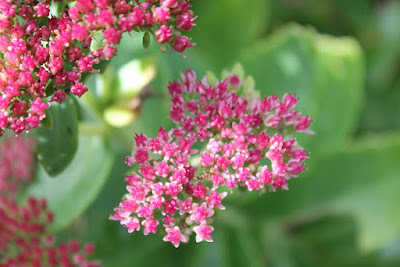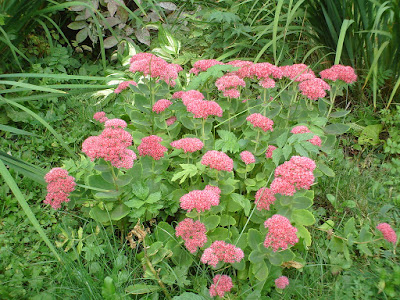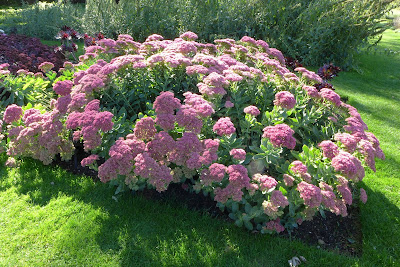Sedum Autumn Joy with the succulent dark green leaves and delicate pink flowers fits nicely into rock gardens, as an edging, or as a border plant and has great potential for both spring and fall sales.
Sedum Autumn Joy plant also called as Stonecrop Herbstfreude, Sedum Herbstfreude, Hylotelephium spectabile Indian Chief, Hylotelephium spectabile Autumn Joy, Hylotelephium Herbstfreude, Sedum spectabile Autumn Joy, Sedum spectabile Herbstfreude, Sedum spectabile Indian Chief, is a hybrid between Hylotelephium telephium (synonym Sedum telephium) and Hylotelephium spectabile (synonym Sedum spectabile). This plant with the succulent dark green leaves and delicate pink flowers fits nicely into rock gardens, as an edging, or as a border plant and has great potential for both spring and fall sales.
IDENTIFY SEDUM AUTUMN JOY PLANT
Sedum Autumn Joy is an herbaceous perennial which grows up to 18 inches tall from a dense crown of shoots that emerge in early spring and look like a nest of crowded fledglings each stretching their neck to get the next worm. The stems are thick and strong and hold aloft the considerable weight of the 3-inch long, fleshy, gray-green leaves and the 4 to 6 inch wide cluster of flowers that appear in late summer.
Autumn Joy naturally blooms from late summer until early fall, giving the garden a wonderful last splash of color at season's end. In early to midsummer, the flower buds have a delightful broccoli-like appearance, with clusters approximately 3-4 inches across. By mid-August, the flower buds swell and develop a light pink color that deepens as the flowers open. This floral display is a progressive event with the plants blooming for about eight weeks. With such an extended blooming period, they are a favorite with butterflies.
As the flower clusters mature, they become a brick red color and eventually dry to a nice dark wheat in the beginning of winter. Once blooms are over, don’t be in a hurry to remove the tops of the plants. The strong stems hold the spent flower heads aloft all winter long and create a pleasing mass of natural dried flower heads. In snowy climates these flower stems create a pleasing effect all winter long as small roofs of snow accumulate on the head.
SEDUM AUTUMN JOY PLANT CARE AND CULTURE
Cultural information should only be used as a guide, and should be to be adapted to suit you. Your physical location; where you grow your plants, how much time you have to devote to their care, and many other factors, will need to be taken into account. Only then can you decide on the cultural methods that best suit you and your plants.
Light:
Sedum Autumn Joy thrives when it is grown under high-light conditions in the garden. They grow best in full sun with a long-day treatment by natural or extended photoperiods of 16 hours or by night interruption from 10 p.m. to 2 a.m. with a minimum light intensity of 10 foot-candles. Planted in partial shade, they become leggy and tend to topple over. However, this can also be an indication that it is time to divide the plant.
Force in the summer or consider providing supplemental lighting from high pressure sodium lamps during the dark winter months to increase branching and overall plant quality.
When possible, shift plants to short days after flower buds are visible to reduce the time to flower and plant height.
Temperature:
Autumn Joy will grow in climates ranging from USDA zones 3 to 10 and is winter hardy to -40°F (-40°C). This plant tolerates a wide range of temperatures, thriving in extreme heat, and often continuing to display right up until the first frosts of winter. Plant height and general plant quality were largely unaffected by production temperatures.
Substrate and growing media:
Sedum Autumn Joy is well-suited for a 5 inch pot with one plug per pot. It also can be an attractive plant in a 1 gallon pot using three plugs per pot or a bare-root plant.
In the garden, this plant tolerates poor soil and some drought stress. Commercially, it grows best in well-drained, evenly moist soil with a pH range of 5.5-6.0.
The spacing of the plants should be wide enough to allow for light to penetrate into the lower part of the plant. This should reduce stretching and minimize disease. Spacing 5-inch pots on 7-inch centers and 6-inch pots on 8-inch centers works well.
Watering:
Sedum Autumn Joy is very drought tolerant requiring no supplemental watering. Even in the heat of summer, light watering every two weeks or so is sufficient. More frequent watering may cause the roots to rot.
Fertilizer:
Feeding is not necessary. The plants will tolerate a light spring feeding with a balanced fertilizer, but excessive fertilizing will cause the plants to become leggy and sprawl in the garden. A constant feed of 100 ppm of a balanced fertilizer such as 20- 10-20 is adequate for good growth.
Pruning:
Cut it back halfway when the stems reach 8 inches tall; this will increase the number of blooms and prevent it from becoming leggy and floppy. Prune dead stems in late fall, or if you leave the plant intact over winter, prune out dead stems in early spring.
Propagation:
Commercially, Sedum Autumn Joy is propagated by spring cuttings. In the garden, this can be accomplished by dividing the root mass in the fall or spring. A more interesting approach to propagation is to cut the fleshy stems in the fall and lay them horizontally in a sunny window. In a month or so, each leaf node will produce a shoot that can be removed and rooted.

















COMMENTS